River Fishing in France Part 1: Tips and Techniques
Share
I hope you don't mind it I veer slightly off the usual subject of bait for a few blogs while I talk about a different kind of fishing, one that gets under your skin and keeps you dreaming of the challenges ahead.
As winter approaches I know a lot of anglers will be planning their holiday trips to France, in all probability to one of the hundreds of commercial lakes that have sprung up over the last fifteen to twenty years. You don't know what you are missing!
For some time now I have shied away from most of the private commercial venues across the Channel, with one or two exceptions. Nowadays my top thrills are to be had fishing French rivers and streams. In my opinion, one of the greatest challenges in carp fishing lies in unlocking the secrets of river carp, and as France has an abundance of rivers holding a similar abundance of carp, that is the country I go to for my river fishing. For some reason or other UK anglers all seem to want to fish the pay lakes, either UK- or French-owned. Why? The rivers there are teeming with fish and they are subject to only light angling pressure.
Logistically French river carping is simpler for me than fishing, say, the Trent, as I live close to the ferry port at Plymouth and by crossing overnight with Brittany Ferries I can get a good night’s sleep before making the relatively short journey to some of the best carp fishing rivers central, southern and western France. For instance, I can be at the water’s edge on some of my favourite swims on the Vilaine in a couple of hours travelling time (excluding the ferry crossing). Then, if I fancy going further afield I can just pop onto the toll roads and in a few hours be down in central or southern France where yet more carp-filled rivers await.
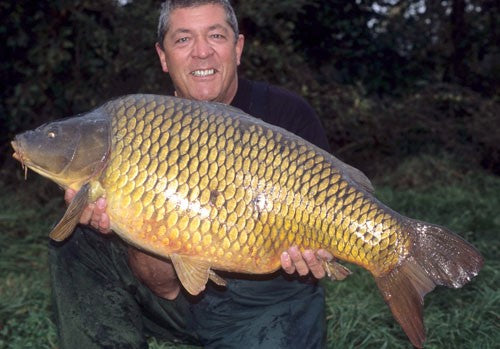
Almost all French rivers hold carp and some pretty impressive ones at that. For instance, this is a 38lb river common of caught from the R. Maine just outside the major town of Angers. Over the years that I have been travelling abroad I guess I must have fished at least a couple of dozen different rivers, ranging from smallish slow-flowing ones like the Butonne to powerful mile-wide rivers such as the Loire.
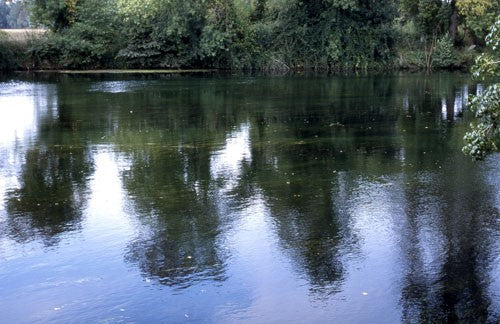
Once you have got the river fishing bug it’s a hard habit to shake off so consequently I have tended to spread my wings over the years and visit pastures new whenever possible. The great thing about the rivers is their unpredictability. Though there may be a few 'known' giants in the rivers for the most part you are targeting whatever comes along. You never know if your next fish will be a double, a twenty or a thirty or even bigger. For instance, even though this seemingly insignificant offshoot of the river the Charente is small it has produced carp to well over forty pounds.
Fluctuating river levels are something that pleasure anglers and river specialists have come to accept as part and parcel of river fishing. However, for carp anglers they can pose serious problems. This is the lower River Lot near Fumel. Calm and peaceful; idyllic even.
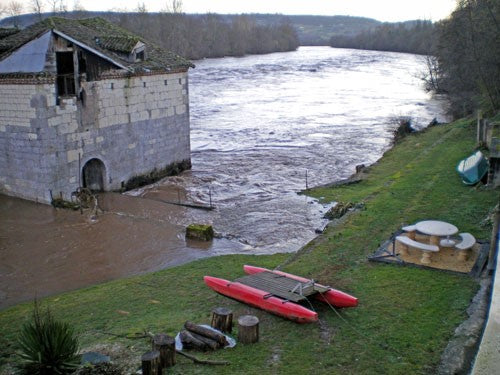
This is the same river in flood! As you can imagine, these are far from ideal fishing conditions and personally for me they are too dangerous to take the risk. However, if you can find a spot out of the turmoil you have every chance of catching, as long as you can hold bottom and your freebies are not swept away miles downstream. In addition, the debris that gets washed off the banks when the river is high can create its own sets of problems. So while rigs are important there are many other things that need to be taken into consideration if you want to achieve success on the rivers.
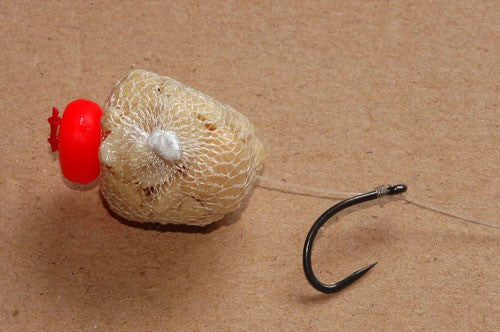
River carp are relatively unpressured and it is unlikely you will need to use fancy or tricky rigs. More important is your choice of the terminal set up which includes rig, lead, hooklink material and so on. For the most part, I have found that river carp tend to feed in groups of more or less same size fish. You may for instance start off catching smaller fish, then suddenly hit a run of big carp. That usually indicates that a shoal of smaller fish has passed through your swim, followed by a shoal of larger ones. The fact that they are shoaling fish means that they feed in a quite aggressive and competitive manner so subtlety is not required. Big hooks, heavy leads and a strong hooklink material are far more useful than the sort of delicate presentations you might use on a pressured UK lake. These Fox XSC size 2 are tough as old boots and should land anything you latch into on the rivers. You will note that I have used the barbless version as I prefer to use barbless hooks or squashed barb ones wherever I fish. The rig is as simple as it comes, 25lb fluoro and a standard knotless knot.
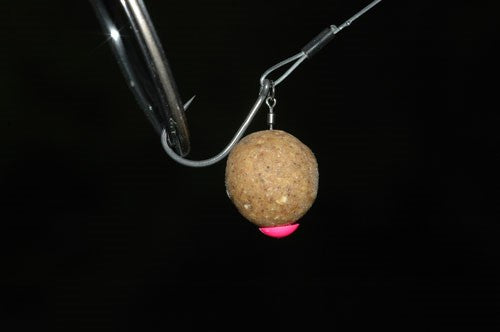
This is a great rig for river fishing for carp. It can ONLY be used with bottom baits, but as I seldom use pop-ups anyway, this is no kind of drawback as far as I am concerned. The Drop-Down Rig is my own creation and I know that many well-known anglers have now used it to great effect. The hook is another of the Fox patterns, in this case, the SSBP again in size 2.
I don’t fish popped up baits in rivers, as I believe they look even more unnatural than they do in a lake. In a river, the current must make the buoyant bait dance about on the bottom in a most unnatural manner. Perhaps on rivers or dead arms where there is less flow, pop-ups are a more realistic proposition but on rivers with a strong powerful current, I cannot see any advantage in their use.

I don't like using round baits as freebies on the rivers - though they are fine for hook baits - as they are affected to a greater or lesser degree by the current. I use chops most of the time as these go a fair distance out of the city and when they settle on the river bed they tend to stay put rather than rolling off downstream.
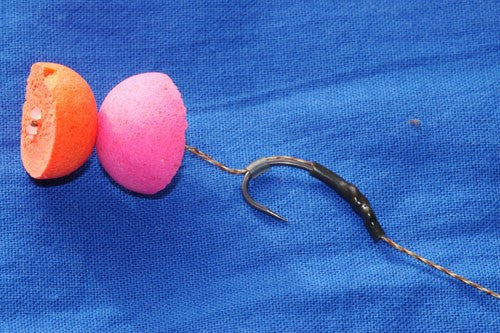
Really you don’t need to knock yourself out over rigs for the river. I use the Drop-Down Rig because it is strong, simple and very efficient but to be honest any well-formed standard rig – perhaps an ordinary line aligner set up as shown here – will do the trick. This set up is as good as anything I have used.
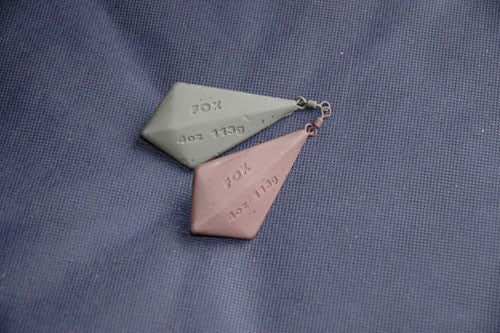
Equally as important as the rig itself is your choice of lead and its design. Generally speaking, you will need pretty heavy leads in most French rivers to counter the current. These Elevator leads are superb but sadly are no longer available. Round leads of any sort are not much use, again due to the current.
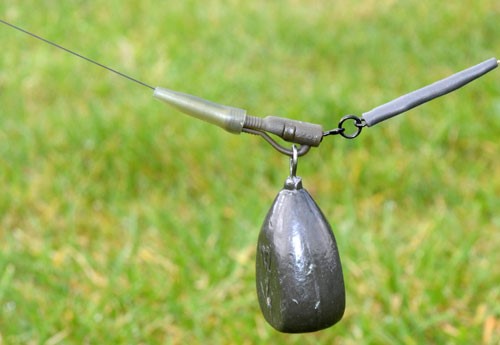
This type of lead is ideal for rivers as it will not be greatly affected by the current. Note the lead clip which is pinned to the swivel. Lead clips may be necessary where major snags, rocks, ledges stones and weed beds are encountered. The last thing you want is for the lead to catch in the bottom, possibly leading to a lost fish and end tackle. Whatever you do PLEASE ensure that the clip you use can be pinned to the hook link swivel as in this photo of the Fox clip. A lead clip that is free-running on the main line is asking for trouble. Not only is it very dangerous for the fish, it is the height of stupidity, and you don't want to look stupid, do you!

Try to keep the rod tips high. This puts less pressure on the line between the rod tip and the lead. It also creates a steeper angle at the surface and this helps to prevent floating debris such as twigs, small branches and leaves from hitting the line and dislodging the lead.

I used to use rod pods on the rivers as there are some stretches where the bank is like concrete. However, where I can do so I now use single banksticks or where the suitable front and rear double bars. The takes from river carp are invariably dramatic affairs, usually screaming runs, so you need the bank side set up to be as solid as possible.
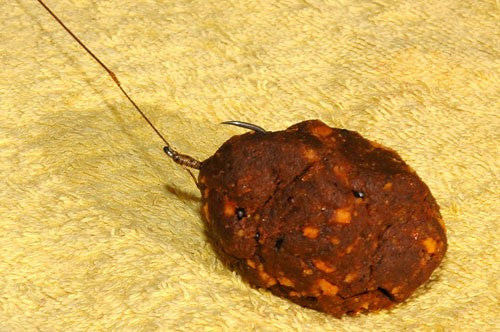
I have been banging on about this little trick of wrapping paste around the hook bait for ages in this blog. The instant, powerful flavour release from the paste encourages smaller fish to investigate. This paste is a blend of Robin Red & fishmeal base mix and MarineRed ground bait mix. Eggs are used to bind the paste and in this instance, I have flavoured it with Blue Oyster from Nutrabaits. As the small fish worry and whittle away the paste their feeding activity often attracts the attention of nearby cars that move in to take the food away from the smaller fish. I half bury the hook in the paste as this helps keep the point clear as the hook bait settles in the current on the river bed.
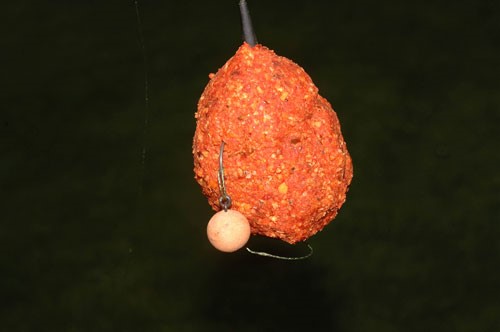
Under the right circumstances ground bait and the method can work wonders on a river. SuperRed is a perfect choice here as it binds very well to the method feeder and only starts to break down slowly once on the river bed. As it does so tiny food items drift downstream drawing carp upstream towards the hook bait.
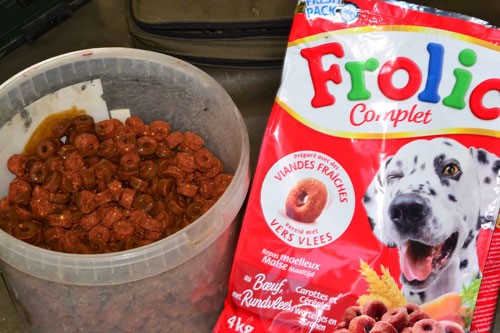
No mention of river fishing would be complete without mentioning Frolic dog biscuits (again!). Frolic is the bee's knees and carp just adore it. If you have read my articles on my trips to Le Queroy and Bounty you will know that I rave about this amazing dog food. Don't ask me why carp like it, as I have no idea. All I can say is Get on it!
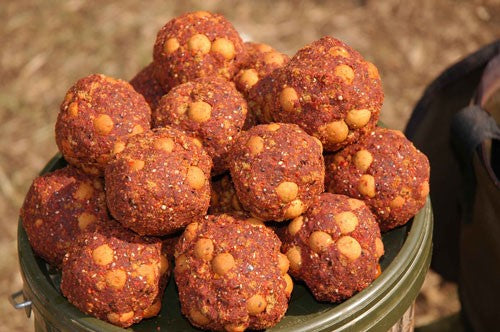
A good tactic for river carping is to use a lot of soft micro seed- and pellet-based ground bait to attract the smaller fish initially. This is particularly effective in rivers where the carp may be a bit thin on the ground compared to some lakes. The feeding activity of small fry invariably attracts any carp in the area and where they go to feed the carp will not be far behind. Ground bait is one of the best ways of encouraging carp to enter your swim and this SuperRed will bind into quite large balls that can be loaded with attractor and perhaps a few boiled baits. Being very dense in nature it falls swiftly to the lakebed where it immediately starts to give off its alluring aromas and tantalising morsels of food goodness.
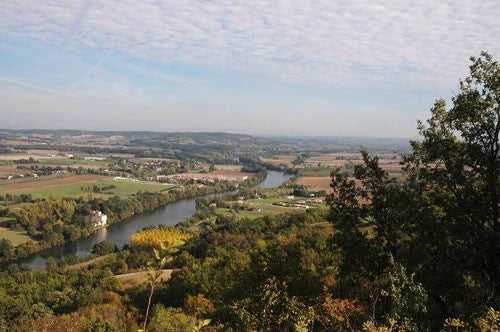
There are so many hundreds of miles of carp-filled rivers in France it is hard knowing where to start. However, don't be put off by this plethora of choice. Once you have located river carp on a river they are not hard to catch but on the other hand, locating them in the first place can be difficult. However, the rewards of river carp fishing can be tremendous and you never know what’s coming along next.
 This sleek powerhouse of a common had in all probability never been caught before. I wouldn’t be at all surprised if it hasn’t been caught since! More on French rivers and how to fish them coming soon!
This sleek powerhouse of a common had in all probability never been caught before. I wouldn’t be at all surprised if it hasn’t been caught since! More on French rivers and how to fish them coming soon!
Written by Ken Townley

